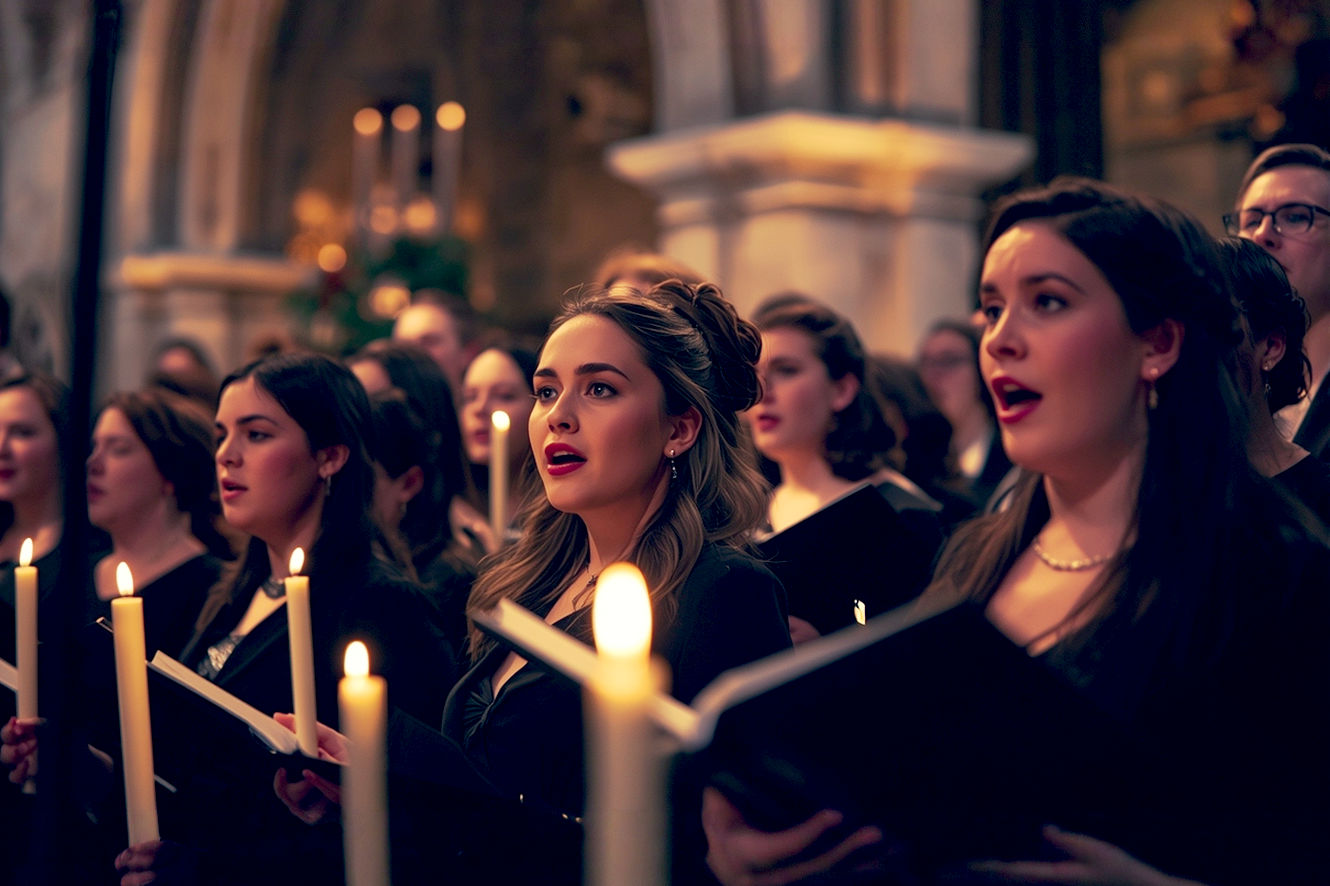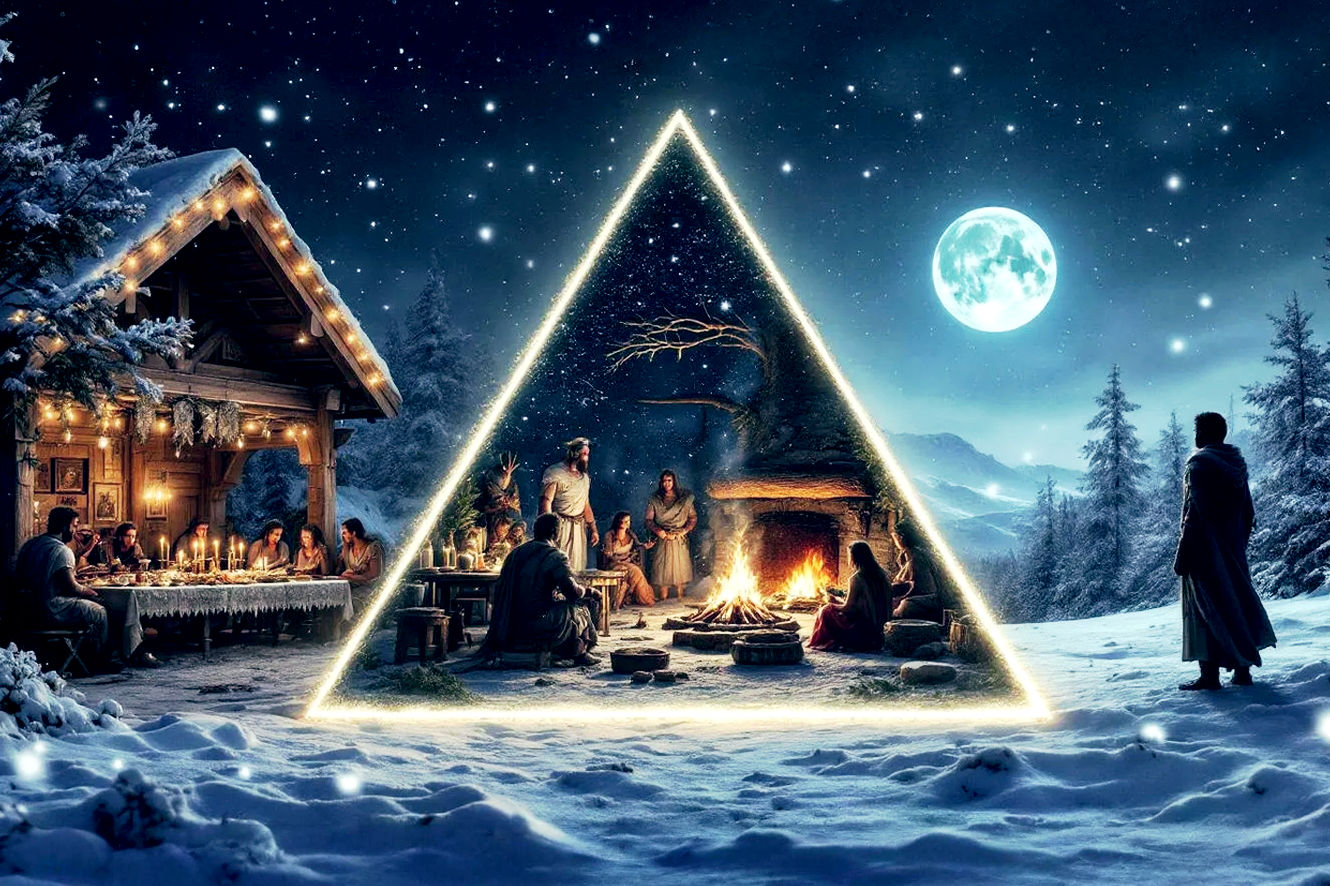This post may contain affiliate links. If you make a purchase through these links, we may earn a commission at no additional cost to you.
If you ask a German child who brings their Christmas presents, you might not get the simple answer you expect. Instead of a straightforward “Santa Claus,” you could hear about a holy bishop, an angelic child with golden hair, or a stern-looking “Christmas Man” who seems suspiciously similar to the American Santa, yet is distinctly his own person. This isn’t confusion; it’s a reflection of a country with a Christmas history so rich, layered, and regionally diverse that it can’t be contained in a single sleigh.
Germany doesn’t have one Santa Claus. It has a fascinating cast of characters forged in history, faith, and folklore. Understanding them is to understand Germany itself—a nation of deep-rooted traditions, theological debates that reshaped culture, and a modern identity that blends the old with the new.
This guide unravels the story of Germany’s gift-bringers, from the benevolent saint who started it all to the fearsome companions who kept naughty children in line. Forget what you think you know about the man in the red suit; you’re about to enter a world far more complex and captivating.
A Tale of Three Christmases: Why Germany Doesn’t Have a Single Santa
At the heart of Germany’s Christmas traditions are three main figures, each with a unique origin story and a distinct role. They are Sankt Nikolaus (Saint Nicholas), the Christkind (Christ Child), and the Weihnachtsmann (Christmas Man). Their stories are not mutually exclusive; in many German families, they coexist, their traditions overlapping and blending in a way that can seem puzzling to outsiders.
Think of them as three layers of history:
- The Ancient Foundation: Sankt Nikolaus is the original, a historical Christian saint whose feast day on December 6th has been celebrated for over a thousand years.
- The Reformation’s Answer: The Christkind was introduced during the Protestant Reformation in the 16th century as a replacement for the Catholic Sankt Nikolaus.
- The Modern Synthesis: The Weihnachtsmann is a more secular figure who emerged in the 19th century, blending elements of Sankt Nikolaus with other European folk traditions and, eventually, the American Santa Claus.
Their prevalence often follows a geographical and religious divide. The predominantly Catholic south and west of Germany have historically been the realm of the Christkind, while the Protestant north and east have long favored the Weihnachtsmann. But in today’s globalized Germany, the lines are blurrier than ever. Let’s meet each of these iconic figures and uncover the stories that make them so enduring.
The Bishop with a Heart of Gold: Sankt Nikolaus, The Original Gift-Bringer
Long before Santa Claus and his reindeer, there was Sankt Nikolaus. He is the historical bedrock of nearly all modern gift-giving traditions, and in Germany, he remains a beloved and distinct figure who has steadfastly refused to be merged with his modern, red-suited counterpart.
Who is Sankt Nikolaus?
Sankt Nikolaus is based on the real-life Saint Nicholas of Myra, a Greek bishop who lived in the 4th century in what is now modern-day Turkey. He was known for his piety and, most importantly, his incredible generosity. Unlike the jolly, pot-bellied Santa, the traditional German Sankt Nikolaus is a stately, slender figure who commands respect.
His appearance is that of a holy bishop:
- Attire: He wears a long, flowing bishop’s vestment (often in white, gold, or red).
- Headwear: He dons a tall, pointed bishop’s hat called a mitre.
- Accessory: He carries a crozier, a long, ornate staff with a curled top, symbolizing his role as a shepherd of his flock.
- The Golden Book: He often carries a large, heavy book, bound in gold, that contains the deeds—good and bad—of all the children he visits.
He doesn’t ride a sleigh pulled by reindeer. Instead, he is said to arrive on a white horse or a donkey, or sometimes simply walks from house to house, his presence more solemn and magical than boisterous.
The Legend of the Three Daughters
The most famous story associated with Saint Nicholas, and the one that cemented his reputation as a secret gift-giver, is the tale of the three impoverished daughters. A poor man had three daughters but could not afford a dowry for any of them. In that era, this meant they were destined for a life of servitude or prostitution.
Hearing of their plight, Nicholas, who had inherited a great fortune, decided to help anonymously. On three separate nights, he went to their house and tossed a bag of gold coins through an open window. One popular version of the story says the gold landed in a stocking or a shoe that had been left by the fireplace to dry. This single act of kindness gave birth to the tradition of leaving out shoes and hanging stockings for a mysterious visitor to fill with gifts.
Nikolaustag: The Day of the Polished Shoes
Sankt Nikolaus does not come on Christmas Eve. His special day is December 6th, known as Nikolaustag (Saint Nicholas Day). On the evening of December 5th, children all across Germany perform a special ritual. They clean and polish their boots—sometimes one, sometimes a pair—and leave them outside their front door, on a windowsill, or by the fireplace.
During the night, Sankt Nikolaus makes his rounds. For children who have been good all year, he fills their shoes with small treasures:
- Oranges, clementines, and nuts: Traditional winter treats that were once a rare luxury.
- Chocolates: Often in the shape of Nikolaus himself.
- Gingerbread (Lebkuchen): A quintessential German Christmas treat.
- Small toys or books.
But what about the children who were naughty? Sankt Nikolaus rarely travels alone. He is often accompanied by a fearsome helper whose job is to deal with the misbehaving children. This is where the story takes a darker, more folkloric turn. Before we meet the modern Weihnachtsmann, we must first understand the figure created to replace Nikolaus.
The Angel in the Parlor: The Rise of the Christkind
In the 16th century, a theological earthquake known as the Protestant Reformation shook the foundations of Christianity in Europe. Its leader, Martin Luther, sought to reform the Church, and one of his goals was to steer the focus of worship away from the veneration of saints and back to Christ himself. This had a direct and lasting impact on Christmas traditions.
A Reformation Revolution: Martin Luther’s New Messenger
Martin Luther felt that celebrating saints like Nikolaus distracted from the true meaning of Christmas: the birth of Jesus. He believed that gifts should be seen as coming from God, not from a bishop. To solve this, he created a new gift-bringer: the Christkind, or Christ Child.
Luther moved the day of gift-giving from December 6th to Christmas Eve, linking it directly to the celebration of Jesus’s birth. He envisioned the Christkind as a representation of the infant Jesus, a holy messenger who brought presents to good children in secret. It was a brilliant move, replacing a Catholic saint with a figure that was undeniably central to the Christian faith. The tradition caught on in Protestant regions of Germany and soon spread to neighboring countries.
What Does the Christkind Look Like?
Over time, the image of the Christkind evolved. While the name means “Christ Child,” the figure is almost never depicted as a baby. Instead, the Christkind is portrayed as an ethereal, angelic being, often with features that are deliberately ambiguous or feminine.
- Appearance: The Christkind is typically depicted as a young girl with long, curly, golden hair.
- Attire: She wears a long white or golden gown, resembling an angel’s robe.
- Crown: She often wears a crown of candles or stars.
- Wings: Angelic wings are a common feature, emphasizing her heavenly origin.
The Christkind is a silent, mysterious figure. She doesn’t land on the roof or come down the chimney. She slips into the house like a whisper, leaves the presents under the Christmas tree, and rings a small bell to let the family know she has been there before disappearing as quickly as she came. This magical, unseen presence is a core part of her charm.
The Christkind’s Realm: Tradition in Southern Germany and Beyond
The Christkind tradition is strongest in the Catholic regions of southern Germany (like Bavaria), Austria, Switzerland, and parts of Italy. Ironically, though it was a Protestant invention, many Catholic areas adopted the tradition over the centuries because its angelic, gentle nature appealed to them.
The most famous embodiment of this tradition is the Nuremberg Christkindlesmarkt (Christ Child’s Market), one of Germany’s oldest and most famous Christmas markets. Every two years, a young woman from the city is chosen to portray the Christkind. Dressed in a magnificent white and gold gown with a towering crown, she officially opens the market with a solemn prologue, becoming a living symbol of the tradition for millions of visitors.
The Man in Red We Know: The Weihnachtsmann, a Modern German Icon
As centuries passed, especially in the more secularized northern parts of Germany, a third figure began to emerge. This was the Weihnachtsmann, which literally translates to “Christmas Man.” He is a composite character, a blend of the stern Sankt Nikolaus and other European winter folktales, who eventually took on the appearance we now associate with Santa Claus.
A Figure Forged in Modernity
The Weihnachtsmann is not a religious figure in the way Sankt Nikolaus or the Christkind are. He is a cultural one. His origins can be traced to the 19th century, a time of growing nationalism and a desire for uniquely German cultural symbols. He was conceived as a secular alternative that both Protestants and Catholics could embrace.
Initially, he was a more serious, solemn figure than the jolly Santa. He was often depicted as a tall, thin old man with a long white beard, wearing a hooded cloak and carrying a Christmas tree. He embodied the spirit of the German forest and the magic of a winter’s night.
From Poem to Pop Culture: The Making of the Weihnachtsmann
The Weihnachtsmann’s identity was solidified in 1835 by a poem titled “Morgen, Kinder, wird’s was geben” (“Tomorrow, Children, There Will Be Something”) by Hoffmann von Fallersleben. The poem describes the Weihnachtsmann bringing a tree, toys, and treats, cementing his role as the primary gift-bringer on Christmas Eve.
However, the Weihnachtsmann’s biggest transformation came after World War II. Through American cultural influence, particularly the pervasive Coca-Cola advertisements of the 1930s, the German Weihnachtsmann began to merge visually with the American Santa Claus. He adopted the now-iconic red suit with white fur trim, the big black belt, and a decidedly more cheerful demeanor.
Weihnachtsmann vs. Santa Claus: Spotting the Differences
While they may look alike, there are still subtle differences between the German Weihnachtsmann and the American Santa Claus.
| Feature | American Santa Claus | German Weihnachtsmann |
|---|---|---|
| Arrival | Comes down the chimney in the middle of the night on Dec 24th. | Often knocks on the door and meets the children in person on Christmas Eve. |
| Origin | Lives at the North Pole with elves. | His origins are more mysterious, often linked to the forest or simply “from outside.” |
| Role | Overwhelmingly jolly and permissive. | Can be more serious, often asking children if they’ve been good and sometimes carrying a switch. |
| Knowledge | “He knows when you’ve been sleeping…” | Relies on his Golden Book or the reports of his companions. |
The Weihnachtsmann is the dominant figure in northern and eastern Germany today and, due to global media, is recognized by children all over the country.
The Enforcers: Germany’s Fearsome Christmas Companions
A German Christmas isn’t all about treats and presents. It also has a strong moral component, a tradition of accountability enforced by a cast of dark and intimidating companions. These figures are the yin to Sankt Nikolaus’s yang, serving as his helpers, enforcers, and the bearers of bad news for naughty children.
Knecht Ruprecht: The Farmhand with a Bag of Ashes
The most common companion, especially in northern and central Germany, is Knecht Ruprecht (Farmhand Rupert). His appearance is the opposite of the pristine Sankt Nikolaus. He is a grim, disheveled figure, often dressed in dark, ragged robes, with a long, unkempt beard and a face smudged with soot.
His role is to test the children. He asks them if they can pray or if they know their catechism. He quizzes them on their behavior over the past year. Children who pass his test receive apples and nuts. Those who fail are threatened with a switch (a bundle of birch twigs) or being stuffed into the large sack he carries on his back. In some traditions, he simply leaves a lump of coal or a bundle of sticks in their shoes instead of treats. He is the classic “bad cop” to Nikolaus’s “good cop.”
Belsnickel: The Fur-Clad Figure of the Palatinate
In the southwestern region of Germany, particularly the Palatinate, the companion is known as Belsnickel. The name comes from belzen (to wallop) and Nickel (a nickname for Nikolaus). He is a wild-looking character, clad in furs from head to toe, his face often obscured by a mask or a long beard.
Like Knecht Ruprecht, he carries a switch to frighten naughty children and a sack full of cakes, candies, and nuts for the good ones. He doesn’t wait for the children to be asleep; he announces his arrival with a loud rattling of chains or the ringing of a bell. The Belsnickel tradition was carried to America by German immigrants, where it became a part of the folklore of the Pennsylvania Dutch.
Krampus and the Alpine Terror
No discussion of dark Christmas companions is complete without mentioning Krampus. While he is most famous in Austria and the Alpine regions of Bavaria, his influence spills into southern Germany. Krampus is a terrifying, demonic figure—a half-goat, half-demon beast with massive horns, a long, pointed tongue, and cloven hooves.
His purpose is singular and brutal: to punish wicked children. On the night of December 5th, known as Krampusnacht, he roams the streets, rattling chains and carrying a bundle of birch sticks to swat the naughty. In the most frightening legends, he stuffs the truly bad children into his basket and carries them away to his lair. Krampus runs are now a popular, albeit terrifying, public spectacle in many Alpine towns.
A Nation Divided by Christmas: The Geographical and Cultural Split
The coexistence of these figures has created a fascinating cultural map of Germany. You can almost draw a line across the country, separating the different Christmas traditions.
The “Christkind-Weihnachtsmann Equator”
This informal line, sometimes called the Weihnachtsmann-Christkind-Äquator, runs roughly from west to east across central Germany.
- To the South: In Bavaria, Baden-Württemberg, and much of the Rhineland, the Christkind is the traditional gift-bringer on Christmas Eve. Sankt Nikolaus still makes his visit on December 6th, but the main event belongs to the angelic messenger.
- To the North: In Lower Saxony, Schleswig-Holstein, Brandenburg, and the eastern states, the Weihnachtsmann reigns supreme. Here, Sankt Nikolaus is a separate, smaller event, and the Weihnachtsmann is the one who brings the tree and the presents on Heiligabend.
Today, this line is heavily blurred. The commercial power of the red-suited Weihnachtsmann has made him a familiar sight even in the deepest Christkind territory. Many families have created their own hybrid traditions: Sankt Nikolaus comes on the 6th, and on the 24th, both the Christkind and the Weihnachtsmann might be invoked to explain where the presents came from.
Christmas Behind the Iron Curtain: The GDR’s Secular Santa
During the Cold War, the socialist government of East Germany (the GDR) actively tried to remove religious elements from public life. This included Christmas. They attempted to rebrand the holiday as a secular, socialist festival. The Christkind was too religious, so the government promoted a secular version of the Weihnachtsmann.
They even went so far as to rename Christmas angels, calling them Jahresendflügelfiguren (“end-of-year winged figures”). This attempt to create a state-sanctioned, non-religious Christmas largely failed to take hold in people’s homes, but it shows how deeply these figures are tied to Germany’s cultural and political history.
German Christmas in Practice: Traditions from Advent to Heiligabend
Understanding the characters is one thing; seeing how they fit into the festive season is another.
Writing to the Heavens: Where German Children Send Their Wish Lists
German children don’t send their letters to the North Pole. They have dedicated post offices that respond to thousands of letters each year. Depending on their family’s tradition, they might write to:
- An das Christkind in Engelskirchen (“Angel’s Church”) or Himmelpfort (“Heaven’s Gate”).
- An den Weihnachtsmann in Himmelsthür (“Heaven’s Door”).
- An den Nikolaus in the town of St. Nikolaus.
Volunteers at these special post offices work tirelessly to send a personal reply to every child who includes a return address.
The Christmas Market Experience: Meeting the Figures in Person
At Germany’s world-famous Christmas markets (Weihnachtsmärkte), you can often meet these figures. You’ll find vendors selling chocolate Weihnachtsmänner and Nikoläuse. At some markets, especially in the south, a local woman portraying the Christkind will make appearances, while in the north, you’re more likely to find a Weihnachtsmann listening to children’s wishes.
Heiligabend (Christmas Eve): The Main Event
For most Germans, December 24th, Heiligabend, is the most important day of the Christmas celebration. This is when the main gift exchange happens. Businesses close by early afternoon, and families gather for a special meal, which can range from simple sausages and potato salad to a lavish goose dinner.
After dinner, the magic happens. In a Christkind household, a bell might tinkle from the living room, signaling that the angel has visited and departed. In a Weihnachtsmann home, there might be a knock at the door, and the Christmas Man himself might step inside to deliver the presents in person. The family then gathers around the beautifully decorated tree to sing carols and open their gifts together.
The Enduring Legacy: Who Brings the Gifts in Germany Today?
So, after centuries of history, who wins the title of Germany’s Santa Claus? The answer is: all of them.
The modern German Christmas is a rich, pluralistic tapestry. Sankt Nikolaus remains the revered saint of December 6th, a beloved tradition that has resisted commercialization. The Christkind continues to be the magical, ethereal spirit of Christmas in the south, her mystique preserved in traditions like the Nuremberg market. And the Weihnachtsmann, in his familiar red suit, has become the de facto face of a secular, globalized Christmas, recognized by all but still holding onto his unique German identity.
Far from being a source of confusion, this multiplicity is a source of cultural wealth. It tells a story of faith, folklore, regional pride, and a nation’s ability to hold onto its diverse past while embracing the present. The next time you see a German Christmas decoration, look closely. You might see a bishop with a staff, an angel with a crown, or a stern man with a bundle of sticks. Each one is a key to unlocking a small piece of Germany’s soul.






